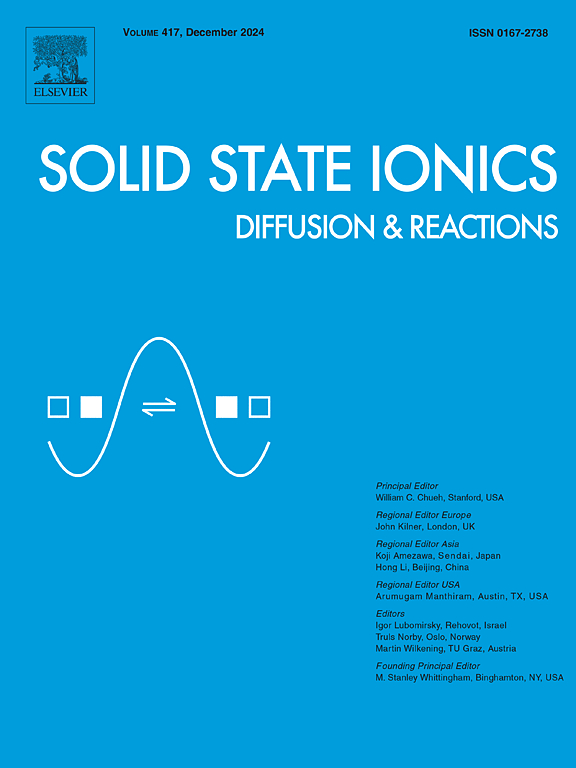Investigating the impact of solid electrolyte particle size/void shape in modulating lithium-ion conduction pathways within graphite composite electrodes using in situ X-ray computed tomography
IF 3.3
4区 材料科学
Q3 CHEMISTRY, PHYSICAL
引用次数: 0
Abstract
Although all-solid-state batteries (ASSBs) have superior safety and higher energy density than conventional lithium-ion batteries (LIBs), concern regarding inadequate power density originate from the poor Li-ion conduction in composite electrode, especially at high C-rate. Tortuosity of solid electrolyte (SE) within the composite electrode has been considered as one of the major components which influence their electrochemical performance. However, research based on structural information for composite electrodes under actual pressure conditions is not sufficient. Here, we investigated the effect of solid electrolyte particle size on the voids and tortuosity of solid electrolyte in composite electrode and electrochemical performance of composite electrodes using in situ X-ray computed tomography. The results showed that fine Li3PS4 resulted in better packing and lowering tortuosity to increasing pressure compared to large Li3PS4, which enhanced the electrochemical performance, especially at higher pressure. A detailed analysis on shapes of voids revealed that plate-like voids with low elongation and flatness disappeared and more spherical voids with high elongation and flatness were emerged as external pressure increased. In addition, the voids in the composite electrode using fine Li3PS4 particles were less likely to interfere with Li-ion conduction pathways, which improved overall battery performance. This study highlights the important role of SE particle size in optimizing ASSB performance through improved microstructural properties.

利用原位x射线计算机断层扫描技术研究固体电解质粒径/空隙形状对石墨复合电极内锂离子传导通路的影响
尽管全固态电池(assb)具有比传统锂离子电池(LIBs)更好的安全性和更高的能量密度,但对功率密度不足的担忧主要来自于复合电极中锂离子的传导能力差,特别是在高c倍率下。复合电极内部固体电解质的扭曲度是影响复合电极电化学性能的主要因素之一。然而,基于结构信息的复合电极在实际压力条件下的研究是不够的。本文采用原位x射线计算机断层扫描技术研究了固体电解质粒径对复合电极中固体电解质的孔隙度和弯曲度以及复合电极电化学性能的影响。结果表明:与大尺寸的Li3PS4相比,细尺寸的Li3PS4具有更好的填充物和较低的弯曲度,从而提高了电化学性能,特别是在高压下。对孔洞形态的分析表明,随着外压的增加,低伸长率、平整度的板状孔洞逐渐消失,高伸长率、平整度的球形孔洞逐渐增多。此外,使用Li3PS4颗粒的复合电极中的空隙不太可能干扰锂离子的传导途径,从而提高了电池的整体性能。本研究强调了SE粒度通过改善微观结构性能来优化ASSB性能的重要作用。
本文章由计算机程序翻译,如有差异,请以英文原文为准。
求助全文
约1分钟内获得全文
求助全文
来源期刊

Solid State Ionics
物理-物理:凝聚态物理
CiteScore
6.10
自引率
3.10%
发文量
152
审稿时长
58 days
期刊介绍:
This interdisciplinary journal is devoted to the physics, chemistry and materials science of diffusion, mass transport, and reactivity of solids. The major part of each issue is devoted to articles on:
(i) physics and chemistry of defects in solids;
(ii) reactions in and on solids, e.g. intercalation, corrosion, oxidation, sintering;
(iii) ion transport measurements, mechanisms and theory;
(iv) solid state electrochemistry;
(v) ionically-electronically mixed conducting solids.
Related technological applications are also included, provided their characteristics are interpreted in terms of the basic solid state properties.
Review papers and relevant symposium proceedings are welcome.
 求助内容:
求助内容: 应助结果提醒方式:
应助结果提醒方式:


